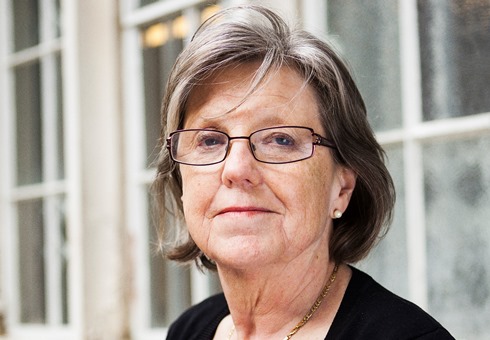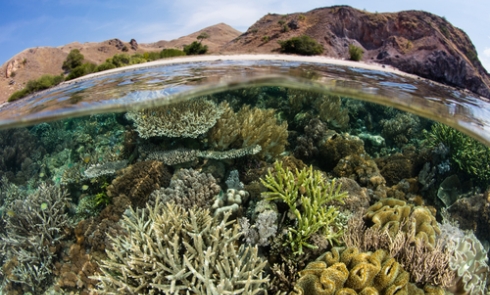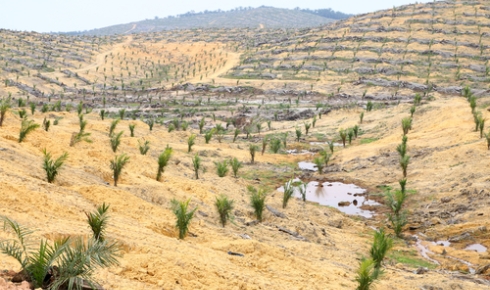Saving the library of life

Tom Ireland talks to Dame Georgina Mace about the scale of the global crisis of biodiversity loss, and how she stays positive in the face of relentlessly worrying trends
The Biologist 65(6) p24-29
Dame Georgina Mace is a professor of biodiversity and ecosystems and head of the Centre for Biodiversity and Environment Research at University College London. Her research focuses on measuring the trends and consequences of biodiversity loss and ecosystem change at a time when species losses are occurring at least 1,000 times faster than background extinction levels.
Honoured with an OBE in 1998 and a CBE in 2007, and made a Dame in 2016, Mace has worked at the interface of science and policy to help the world manage its ecosystems and conserve biodiversity. She led the development of the International Union for Conservation of Nature (IUCN) Red List for threatened species and was on the biodiversity element of the Millennium Ecosystem Assessment, a huge and groundbreaking appraisal of the world’s ecosystems.
She has been director of the NERC Centre for Population Biology, director of science at the Zoological Society of London’s Institute of Zoology, and president of the British Ecological Society.
You describe biodiversity as the ‘library’ of life on Earth. How close are we to understanding fully what is in that library?
In its broadest sense, biodiversity could mean all of life on Earth, and everything that is diverse about life – ecosystems, species, genes. Or it could be different ways of functioning; different ecological communities. In ecological science, people tend to have a few iconic measures of it: things like species richness or species diversity. Those are measurable and I think those are knowable.
When you get into the diversity of all life on Earth, it becomes very complicated. The genetics side of diversity – all of the genes on Earth – is suddenly becoming knowable. That will become really interesting in the next five or 10 years.
When we talk about biodiversity loss, we tend to think of species going extinct. But in what other ways are we losing diversity?
The simplest thing to focus on is species – quite rightly in some cases, because that is the irreplaceable bit. I tend to think in two dimensions: local to global. The amount of nature at a global level is species numbers, but I think the thing that matters on a local level is the loss of local functional aspects of ecosystems or even just a simplification of an ecosystem.
We are in the midst of what is seen as a mass-extinction event caused by human activity. How is it that species numbers are increasing in many areas such as the UK?
That’s really interesting and I think it’s true that the UK has more species now than at any time in its history. So that seems really hard to understand when we’re talking about a species-extinction crisis. However, it comes from this local versus global difference: some species are everywhere, and an area can gain species [ie invasive species], but the ones we are losing are the local, distinctive endemics.
Europe has already lost most of its forested land to agricultural and other uses. Are there lessons we can use from this before it happens in more species-rich areas of the world? Apart from to not do it, of course.
I don’t think we can stop it happening elsewhere, because we need the land to feed a growing population. There is a very interesting set of lessons from the way Europe has developed from small farms to industrial agriculture, where you just homogenise the landscape for miles and miles. With a local-scale agricultural landscape, you can still maintain a lot of diversity, and that’s what Europe was like for most of the 20th century.
The problem is where it will happen next: the tropics is not exactly like the temperate areas of Europe. These are very species-rich areas, and it’s not clear that species in the tropics are going to be as resilient in the face of these changes. The other set of lessons comes from the Americas, the US particularly, where they have vast wilderness areas where there are no people and they do their agriculture very intensely elsewhere. There is a big debate at the moment about what diversity these areas can support.
I’ve seen you describe your work as “trying to understand when or where the loss of biodiversity reaches a point where there are serious or irreversible consequences”. What will some of the signs be if our window of opportunity has closed or we are beyond the point of no return?
With biodiversity loss, we can think any loss is bad and any recovery is good. In the real world, though, where there are lots of pressures on the land, you need to have some stopping points. When is the loss really going to cause major problems rather than just inconvenience? We can’t just do conservation: we have to meet all these other needs from the land, too. What recovery is enough? So I’m still interested in defining that ‘safe space’, if you like.
I think the most immediate signs we would see would be epidemics affecting people or crops that we are simply unable to control – we’ve either lost the diversity of species or genes that lets us adapt to them. Some problems might be more ‘slow burn’. At the moment, there is a lot [of discussion] about the idea that if you are unable to get out into some green space, it is very much harder to recover from depression or other mental illness. So it could be that some things like that, which are much harder to disentangle from other issues, will take place more slowly but will be very difficult to recover from.
Do you think the public understands the severity and urgency of biodiversity loss?
No, and I don’t think as scientists we’ve been able to communicate the significance or urgency in the same way as we have for climate change. And maybe that’s because we can’t put our finger on what in particular is urgent.
However, I think a lot of people are concerned about species loss, even if it’s species we may never see. This summer there’s been a lot of debate about whether we are losing all our insects – ‘the windscreen splatter effect’ and other measures. That is probably a loss of abundance, though – the amount of wildlife you see – but it’s something that people have really started to take notice of.
 A biodiverse and healthy coral reef below the waves in Komodo National Park, Indonesia
A biodiverse and healthy coral reef below the waves in Komodo National Park, IndonesiaWas a lack of urgency and public interest what led to the need to start ‘valuing nature’ as a way to help people understand what the natural world does for us?
Partly. I think one of the reasons we are continuing to lose biodiversity at increasing rates is that it’s perceived to be a bit of a luxury item. It’s something that you pay attention to when you’ve taken care of all the important things governments do.
I got interested in the natural-capital accounting work to just get it into the same planning framework as all those other things. It is interesting that we have an Office for National Statistics that reports on the country’s assets and yet we deal with the natural environment so weakly in that process. We should take account of what nature we have in the country and what condition it is in.
The concept of natural capital or valuing nature is not without its critics. What do you think are some of the main misconceptions about these ideas?
The main thing is that it is perceived to be about putting a monetary value on nature. Some people just object to that in principle – that it somehow demeans nature. Some people think it means you are going to sell it. I think both are really understandable, but they are misconceptions. In my view, natural capital is not about monetisation or about selling. It’s really the other way round: if you show how valuable something is in terms of what would happen if you lost it, then you can justify resources to invest in and sustain it.
We haven’t ever listed these things before. We haven’t said how much we depend on flood plains, trees for carbon sequestration, clean water sources. So the argument to invest in these things is just not there; nature is seen as a luxury just for people going birdwatching.
What do you think has been your most important work?
I suppose what has had the biggest impact is the IUCN Red List. We started that about 30 years ago and it was finished by about the start of the 2000s, and I am proud of the fact that what we did is still being used and adapted, and has definitely had an impact.
Another of the things I am rather pleased with is the work we did on which species are vulnerable to climate change, which at the time was quite innovative. I enjoyed bringing together the ecology and evolution with the physical climate science.
What did you think of the government’s recent 25-year environmental plan?
I was involved in some of the early development of it. I like that it has these quite ambitious outcomes for 25 years hence; it lays out how we want the environment to be then and draws a line in the sand. It’s a pity these targets are not a bit more quantifiable or explicit. But clean air, clean water, wildlife thriving, hazards reduced – all of those are great. I think the biodiversity target is good, and it should take us away from this siloed approach so we think about carbon, water and wildlife all at once.
I thought it was unfortunate that when it was launched, it appeared to be all about plastic-bag taxes, which was just an accident of timing. So this visionary idea disappeared into a plastic-bag thing.
Funding for conservation is rising, but species losses are not showing any sign of abating. The big question is, what are we doing wrong?
I think it’s because conservation is done in a silo; it’s done on its own. It’s often in conflict with other decisions. Treating conservation in opposition to food production and water is just never going to work, and I feel we’ve done too much of that in the past – something that’s been an obstacle rather than helping the others achieve their own ends.
We’ve just finished a very big project and book on ecosystem services for poverty alleviation, and one of the big conclusions was that you cannot tackle societal development and environmental sustainability separately. They are not separate activities; you have to do these things together.
 Young palm oil plants, and a stark change in land use, in southeast Asia
Young palm oil plants, and a stark change in land use, in southeast Asia How do you see the environmental movement more generally? Is it winning over those who deny we are in environmental crisis?
It’s become more polarised. There have always been people who say we can techno-fix it all and not to worry about it. It seems like the environmentalists are getting more extreme too – the sort of ‘half-Earth’, ‘nature-needs-more’ people who want to give half the planet back to wilderness; and then there are eco-modernists who say we can fix all of this with science and intensive agriculture. For those in the middle, those sides seem more extreme than they used to be.
What do you make of the ideas of using synthetic biology and de-extinction as a way of reintroducing lost traits?
Of course we should make use of genetic technology where it can be used to engineer or manage crops or strains or vaccines, or for creating whole new ways of dealing with societal problems.
I don’t see the logic of de-extinction at all. We could create a mammoth or a dodo, but it would not be the same. They had a population structure and a biogeography and were the product of millions of years of evolution in situ. If you did it, you’re really just getting a museum specimen. Let’s not pretend it’s the same as a wild species.
To try to end on a positive note, how do you stay motivated in the face of so many disturbing graphs showing species loss and human activity just relentlessly accelerating?
People are incredibly creative and innovative. We just need the right leadership. We are creating all this understanding and that means the right levers can one day be pulled. The other thing is something I’ve changed my mind about in the last year or so. The graphs do seem relentless, but we don’t have to worry just about ecosystems changing.
People have changed the Earth throughout history, but the important thing is to not let them change [ecosystems] into states that are impossible to live in. What is the environment that will give everyone a fulfilling sustainable life? If you look at health and education, they have all improved drastically in the past century, and we’re just trying to keep us on that path and make sure environmental degradation doesn’t undermine it.
I think that’s a very positive way of looking at it.
21–22 May, The Crystal, London
The meeting will reflect on the past 10 years of natural capital thinking and the latest innovations in research, policy and practice.
Confirmed speakers include Professor Ian Boyd, chief scientific adviser at the Defra, Katherine Willis CBE, Professor of Biodiversity at the University of Oxford, Mark Gough, executive director of the Natural Capital Coalition, and many more.
Visit naturalcapitalinitiative.org.uk for more information about attending


